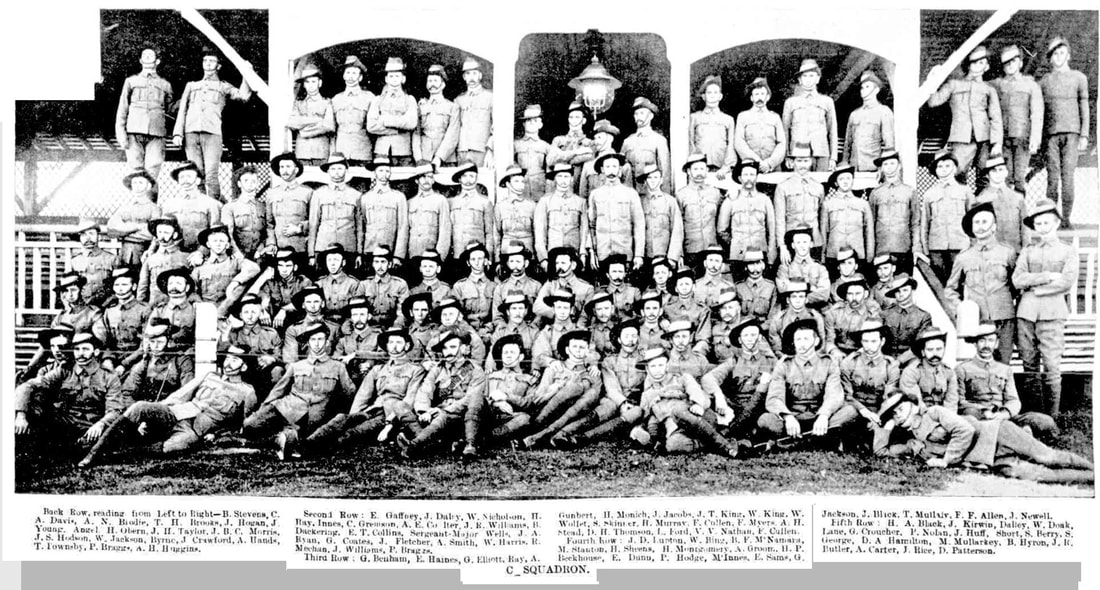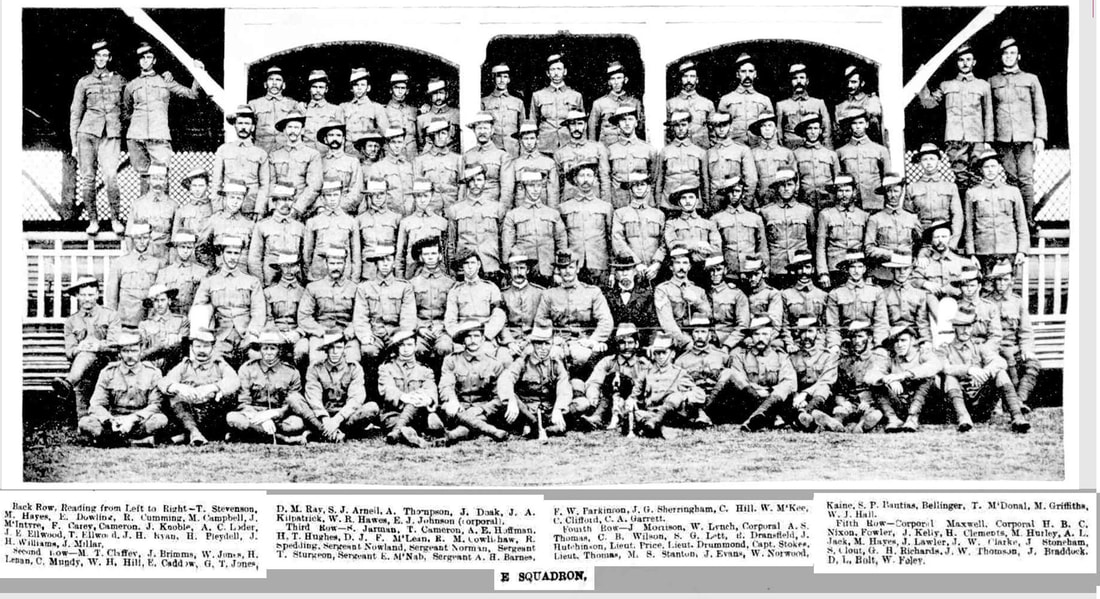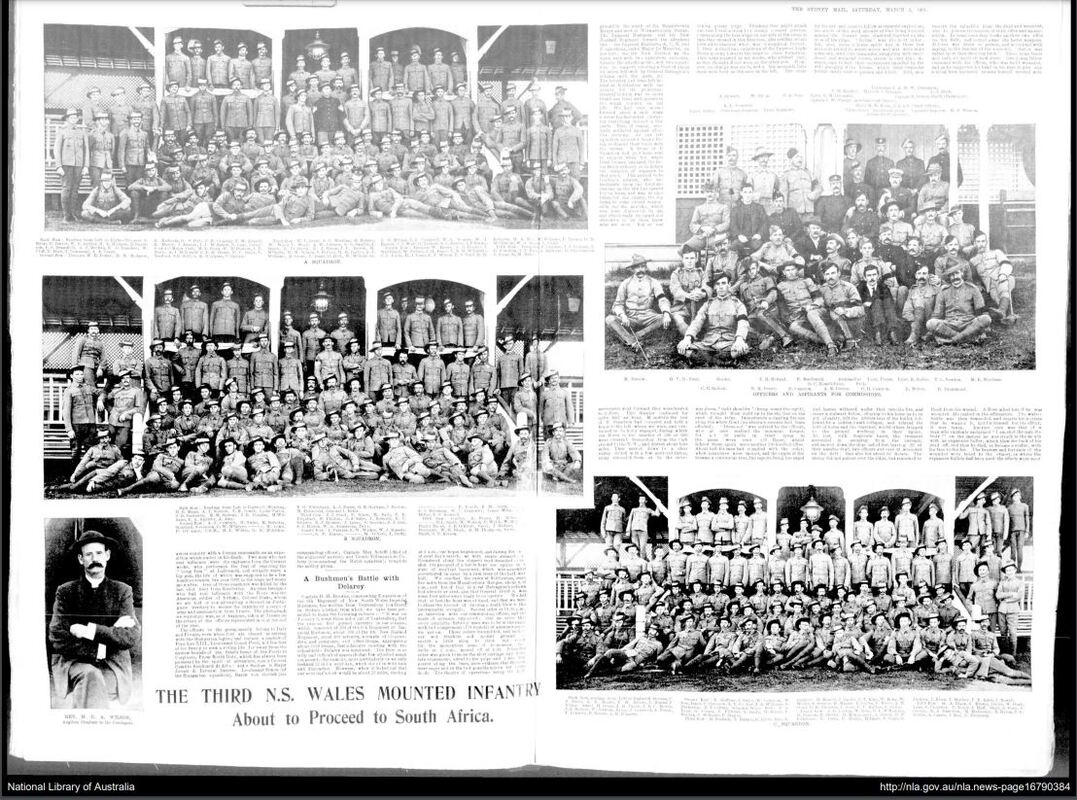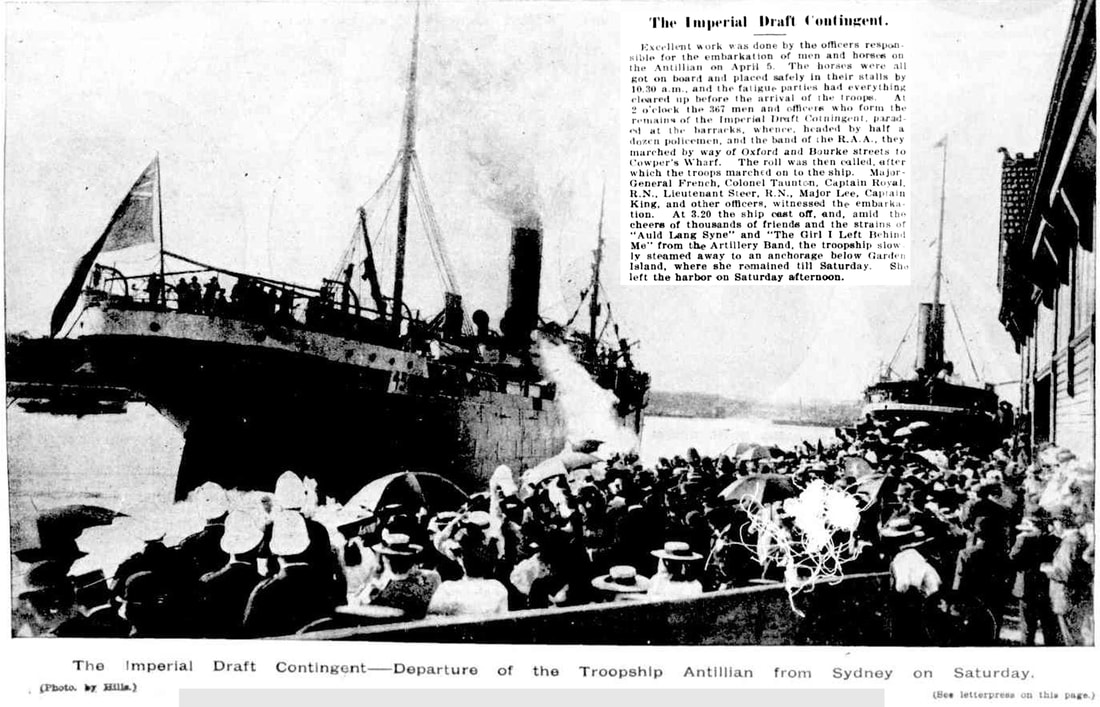Boer War 1899 - 1902
T A Lesslie, Trooper, Serial 3055
The 3rd Regiment of the New South Wales Mounted Rifles was established in Sydney along the same lines as the two previous regiments. The 3rd Mounted Rifles consisted of five mounted rifle squadrons and a machine gun section. The preference for recruits was for trained men who were "good shots and riders". They needed to be between the ages of 20 and 40, 5 foot 6 inch or taller, and have a chest measurement of 34 inches or larger. They also needed to be unmarried. The total strength of the regiment was 37 officers and 980 other ranks, with 1,000 horses. Nearly all of the officers had previously served in South Africa.
The 3rd Mounted Rifles was the sixth and final contingent sent by New South Wales to the war.
The regiment traveled to South Africa in three group: B and D Squadrons were the first to leave Australia, sailing from Sydney on 15 March, on board the transport Maplemore; A, C, and E Squadrons, and the regimental staff, followed six days later on the British Princess. The machine gun section also left on 21 March, travelling on the transport Ranee. B and D Squadrons disembarked at Port Elizabeth on 12 April, while the rest of the regiment disembarked at Durban on 17 and 23 April. Another draft was also sent from Australia to reinforce the regiment. These men traveled on board the Antillian, leaving Sydney on 5 April and arriving at Durban on 12 May.
From 2 May 1901 to 28 April 1902 the regiment served in the eastern Transvaal and in eastern Orange Free, attached to Colonel Remington's column. In early 1902 it took part in several drives, the principal one being the Harrismith drive, which resulted in the capture of 251 prisoners, 26,000 cattle, and 2,000 horses. In February 1902 the regiment was in action during the Boer breakthrough at Langverwacht.
In May the regiment embarked at Cape Town for Australia, leaving on 4 May and reaching Sydney on 3 June, after having stopped at Albany, Adelaide, and Melbourne.
The images below were taken from 1901 Sydney Newspapers. Scroll below for names. Click to enlarge
The 3rd Mounted Rifles was the sixth and final contingent sent by New South Wales to the war.
The regiment traveled to South Africa in three group: B and D Squadrons were the first to leave Australia, sailing from Sydney on 15 March, on board the transport Maplemore; A, C, and E Squadrons, and the regimental staff, followed six days later on the British Princess. The machine gun section also left on 21 March, travelling on the transport Ranee. B and D Squadrons disembarked at Port Elizabeth on 12 April, while the rest of the regiment disembarked at Durban on 17 and 23 April. Another draft was also sent from Australia to reinforce the regiment. These men traveled on board the Antillian, leaving Sydney on 5 April and arriving at Durban on 12 May.
From 2 May 1901 to 28 April 1902 the regiment served in the eastern Transvaal and in eastern Orange Free, attached to Colonel Remington's column. In early 1902 it took part in several drives, the principal one being the Harrismith drive, which resulted in the capture of 251 prisoners, 26,000 cattle, and 2,000 horses. In February 1902 the regiment was in action during the Boer breakthrough at Langverwacht.
In May the regiment embarked at Cape Town for Australia, leaving on 4 May and reaching Sydney on 3 June, after having stopped at Albany, Adelaide, and Melbourne.
The images below were taken from 1901 Sydney Newspapers. Scroll below for names. Click to enlarge
FULL PAGE IMAGE'S
T. A. Lesslie, Trooper, Serial Number 3055
The Boer War Database states : -
Extracts and Comments - “Not identified amongst photos of NSW Drafts 3. 1901”.
LEST WE FORGET
The Boer War Database states : -
Extracts and Comments - “Not identified amongst photos of NSW Drafts 3. 1901”.
LEST WE FORGET
The Queen's South Africa Medal (QSA) was awarded to military personnel who served in the Boer War in South Africa between 11 October 1899 and 31 May 1902. Units from the British Army, Royal Navy, colonial forces who took part (Australia, Canada, New Zealand, India and South Africa), civilians employed in official capacity and war correspondents. The QSA (without bar) was also awarded to troops who guarded Boer prisoners of war at the POW camp on the island of St. Helena. Troops on the Mediterranean islands were awarded the Queen's Mediterranean Medal, and some personnel on troopships got the Transport Medal.
The QSA was the medal issued to all who served in South Africa up to the end of the war in May 1902. This included those such as the New Zealand 10th Contingent who arrived in Durban in May 1902, and did not fight. The requirements for the King's South Africa Medal meant that few were issued.
The QSA was the medal issued to all who served in South Africa up to the end of the war in May 1902. This included those such as the New Zealand 10th Contingent who arrived in Durban in May 1902, and did not fight. The requirements for the King's South Africa Medal meant that few were issued.
Clasps
There are twenty-six different clasps added to the medal indicating each action and campaign of the Second Boer War. A “state” clasp was issued for service within that state when no “battle” clasp was issued to the recipient for a specific action within the same state. This meant a QSA medal could not carry both a “state” clasp and a “battle” clasp for actions within the same state. Recipients could not get both the "Defence" and "Relief" clasps for Mafeking, Kimberley or Ladysmith. The "Rhodesia" clasp was not issued with the "Relief of Mafeking" clasp, nor were the "Cape Colony" and "Natal" clasps issued together (except for Pte. Wingell, a Royal Marine attached to the Army.
There are twenty-six different clasps added to the medal indicating each action and campaign of the Second Boer War. A “state” clasp was issued for service within that state when no “battle” clasp was issued to the recipient for a specific action within the same state. This meant a QSA medal could not carry both a “state” clasp and a “battle” clasp for actions within the same state. Recipients could not get both the "Defence" and "Relief" clasps for Mafeking, Kimberley or Ladysmith. The "Rhodesia" clasp was not issued with the "Relief of Mafeking" clasp, nor were the "Cape Colony" and "Natal" clasps issued together (except for Pte. Wingell, a Royal Marine attached to the Army.
BOOKLETS
Official records
SOURCE THE 3rd REGIMENT N.S.W. MOUNTED RIFLES and DRAFTS (1901, March 9). The Sydney Mail and New South Wales Advertiser (NSW : 1871 - 1912), p. 597. A Bushmen's Battle with Delarey. (1901, March 2). The Sydney Mail and New South Wales Advertiser (NSW : 1871 - 1912), p. 536. 3rd New South Wales Mounted Rifles. (n.d.). Www.awm.gov.au. Retrieved October 12, 2022
Disclaimer |
Report Something Broken
© 2013 - Suzanne Nagel historicalfamilies.com



















